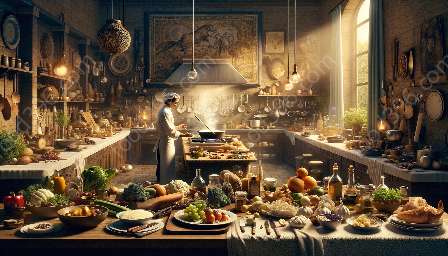Medieval European cuisine offers a rich tapestry of flavors, ingredients, and culinary techniques that have left a lasting impact on European food culture. From the influence of trade routes to the evolution of cooking methods, this topic cluster will take you on a journey through the captivating history of medieval European cuisine, exploring its connections to broader European culinary traditions.
The Origins and Influences of Medieval European Cuisine
Medieval European cuisine was shaped by a wide range of influences, including cultural exchanges, trade routes, and technological developments. The cuisines of different regions within Europe were also influenced by their unique geographical features and available resources. The fusion of these diverse influences gave rise to the rich and varied culinary traditions that characterize medieval European cuisine.
Trade Routes and Culinary Exchange
One of the key factors that shaped medieval European cuisine was the extensive network of trade routes that connected Europe to the rest of the world. The spice trade, in particular, brought an array of exotic flavors and ingredients to European kitchens, transforming the way food was seasoned and prepared. The introduction of spices such as cinnamon, pepper, and cloves had a profound impact on the development of European cuisine, and their exotic origins added an element of prestige to dishes that incorporated these luxurious ingredients.
Regional Diversity and Ingredients
Medieval European cuisine also reflected the regional diversity of the continent, with different regions embracing their unique culinary identities. The availability of local ingredients, such as seafood, game meat, grains, and vegetables, influenced the development of regional dishes and cooking styles. For example, the cuisine of coastal regions often featured an abundance of seafood and shellfish, while inland areas relied heavily on game meat and root vegetables.
Key Ingredients and Cooking Methods
The ingredients and cooking methods of medieval European cuisine were as diverse as the regions that produced them. Understanding these elements is essential to appreciating the rich tapestry of flavors that defined this era of culinary history.
Staple Foods and Grains
Grains, particularly wheat and barley, formed the foundation of medieval European diets. Bread, in various forms, was a staple food for people across the social spectrum, from peasants to nobility. The cultivation and processing of grains, as well as the development of various bread-making techniques, played a central role in medieval European cuisine.
Meats and Game
Meat was a significant component of medieval European cuisine, with a wide variety of game meats, such as deer, boar, and rabbit, being consumed alongside domesticated animals like cattle, pigs, and poultry. The use of salt, smoking, and drying methods allowed for the preservation of meats, ensuring a sustainable supply during the harsh winters and lean periods.
Herbs, Spices, and Flavors
The use of herbs and spices added depth and complexity to medieval European dishes, transforming simple ingredients into flavorful culinary creations. The cultivation of herbs such as parsley, thyme, and sage, as well as the importation of exotic spices from distant lands, greatly expanded the repertoire of flavors available to medieval European cooks.
The Legacy of Medieval European Cuisine in European Culinary History
The influence of medieval European cuisine reverberates through the annals of European culinary history, leaving behind a lasting legacy that continues to shape modern European gastronomy.
Culinary Techniques and Innovations
The cooking methods and techniques developed during the medieval period laid the groundwork for many practices still in use today. From the art of pickling and preserving to the refinement of culinary skills in noble households, the innovations of medieval European cuisine continue to inform contemporary cooking styles and approaches.
Cultural Traditions and Celebratory Feasts
Medieval European cuisine was closely intertwined with cultural traditions and celebratory feasts, playing a central role in festivals and rituals throughout the year. The legacy of these traditions can be seen in modern European culinary customs, from the elaborate preparations for holidays and special occasions to the enduring importance of communal dining and shared meals.
Artistic and Symbolic Representations
The artistry and symbolism of medieval European cuisine can still be appreciated in the visual and conceptual elements of contemporary European dishes. The elaborate presentations, decorative garnishes, and symbolic meanings imbued in medieval food artifacts continue to influence the aesthetics and storytelling aspects of modern gastronomy.
Exploring the Rich Tapestry of Medieval European Cuisine
Medieval European cuisine, with its diverse influences, staple ingredients, and enduring legacy, offers a captivating lens through which to view the broader history of European food culture. Delving into this topic cluster, you'll gain a deeper appreciation for the intersection of culinary history, cultural exchange, and the enduring appeal of flavors that have stood the test of time.

